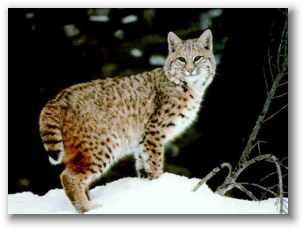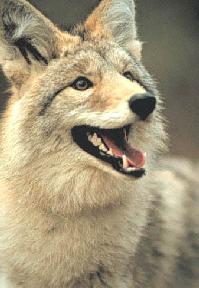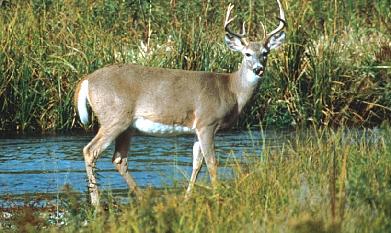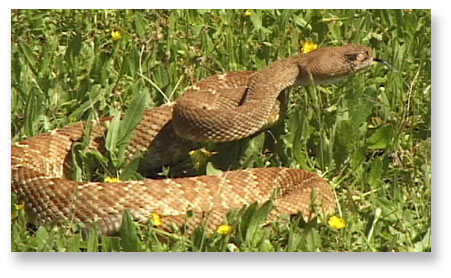
Ridgewood is home to many wildlife animals. Although we have occupied their territory, it is still their home. Nature's balance is maintained through a balanced animal population. Both bobcats and coyotes are predators of rodents, skunks, porcupine, raccoons, snakes, deer and other small animals. As a result of the predators presence in Ridgewood, pesky unwanted animals are kept in check.
Both bobcats and coyotes will also dine on household pets such as cats and dogs. Since these predators are both primarily nocturnal hunters, it is highly suggested that you keep your household pets in at night. Bobcats and coyotes may be occasionally seen during day, but normally avoid cleared areas (like around houses) and the presence of people. Killing these predators may be viewed as protecting your pets, but the penalty will be an increase of undesirable wildlife.
The following describes some of the wildlife that inhabits Ridgewood:

Found only in North America, where it is the most common wildcat, the Bobcat gets its common name from its stubby, or "bobbed," tail. The animal spends less time in trees than the Lynx, resting by day in a rock cleft, thicket, or other hiding place, but is also an expert climber. Sometimes it rests on a boulder or a low tree branch, its mottled fur providing excellent camouflage; if hard-pressed, it will swim. The Bobcat’s home range varies in size with sex, season, and prey distribution and abundance. It marks its range using urine (in large or small amounts that it may cover up), feces (also sometimes covered up), anal gland scent, and scrapes and scratches. It uses the same hunting pathways repeatedly to prey mostly on the Snowshoe Hare (in the northern U.S.) and cottontails (in the eastern U.S.), but also on mice, squirrels, Woodchucks, Virginia Opossums, moles, shrews, Common Raccoons, foxes, domestic cats, birds, reptiles, Common Porcupines, and even skunks. The Bobcat, like many larger predators, can fast for some time when food is not available, but eats heavily when it is. The animal consumes small prey immediately, but caches and revisits larger kills. The Bobcat and the Lynx are capable of killing prey as large as deer, but they seldom do so except in deep snow, when food is scarce, or when fawns are available. The Bobcat hunts small prey by waiting for victims motionlessly and then pouncing; pursues medium-size animals from a hunting bed or lookout, attacking by stalking and then rushing, or by simply rushing; and seeks large prey such as deer when they are bedded down. After a rush, the Bobcat will bite at the throat, base of skull, and chest. Occasionally the species preys upon livestock, especially poultry. When food is scarce the Bobcat will eat carrion, usually animals killed by cars or by hunters. This wildcat has a natal or maternal den and other auxiliary or shelter dens in less-visited portions of its home range. The natal den, with a nest of leaves or other dry vegetation, is often in a cave or rock shelter, if available, but can be in a hollow log, under a fallen tree, or in another protected place. Brush piles, rock ledges, stumps, hollow logs, or similar protected places serve as auxiliary dens. Like the Lynx, the Bobcat is a solitary animal, the sexes coming together only for mating. The Bobcat generally does not mate until its second year. Males are sexually active all year, but most females are in heat in February or March. More than one male may be attracted to a female; the female and dominant male may mate several times after a series of chases and "ambushes." The other males remain apart during mating, but the female may mate with them later. The young are well furred and spotted at birth. They begin exploring at one month and are weaned at two. By fall they are hunting on their own, but remain with the mother for nearly a year. The various calls of the Bobcat sound much like those of the domestic cat, although its scream is piercing. When threatened, the animal utters a short, sudden, and resonant "cough-bark." It yowls loudest and most often during the breeding season. Humans (who hunt Bobcats with hounds in some areas) and the automobile are this animal’s worst enemies, but predators such as foxes, owls, and adult male Bobcats may attack the young. Populations are stable in many northern states and are reviving in other states where intensive trapping formerly decimated the species. In some states, such as New Jersey, the Bobcat is being reestablished.

The coyote has grayish brown to yellowish brown fur on top and whitish fur on its under parts. It has large triangular ears on the top of its head and a long, narrow muzzle. It has a black nose, yellow eyes and a long bushy tail. One way to tell the coyote apart from wolves and dogs is to watch its tail when it runs. The coyote runs with its tail down. Dogs run with their tails up and wolves run with their tails straight out.
The coyote does most of its hunting alone and at night. It is carnivorous. Most of its diet is made up of mammals, but it also will eat birds and snakes. It prefers to eat fresh kill, but it will eat carrion. In the fall and winter, the coyote often eats fruits, vegetables and berries. When hunting small prey like mice, the coyote will stand still with its legs stiff and then pounce on its prey. When hunting larger prey like deer, coyotes hunt in packs. One or more coyote will chase the deer while the others wait, then the next pick up the chase. Working in teams like this the coyote can tire the deer out, making it easier to kill. Coyotes also often follow badgers and catch prey that pop out of burrows the badger is digging.
The coyote mates between February and April. The female may mate with more than one male. Two months after mating the female can give birth to between one and nineteen pups, though the average litter size is usually around six. The pups are born blind and with floppy ears. They will open their eyes in about ten days. The pups will begin to come out of their den when they are about three to four weeks old. They are weaned when they are about a month old. Once they are fully weaned, both parents feed the pups regurgitated food. Male pups will leave their mother when they are between six and nine months old. Female pups will stay with their mother's pack. Male and female coyotes pair off and mate together for several years.
Coyotes make their dens in rocky crevices, logs, caves, or the dens of other animals. They usually don't dig their own den. They usually will find an abandoned den of a badger or a fox and enlarge it.
Coyotes are very vocal animals. They have three distinct vocalizations: the bark, the yelp and the howl. They usually use these calls in combination to let the pack know where they are.

White-tailed deer are tan or brown in the summer and grayish brown in winter. The have white on their throats, around their eyes, and nose, on their stomachs and on the underside of their tails. Males have antlers. Males weigh between 150 and 300 pounds and female weigh between 90 and 200 pounds.
White-tailed deer have scent glands on the hooves of all four feet. They also have scent glands on the inside of their rear legs. The scent from these glands are used for identification and during mating season.
Males have antlers. They shed them between January and March. The antlers will grow again in April or May. New antlers have soft covering called velvet on them. The antlers will lose the velvet in August or September.
White-tailed deer are herbivores or plant eaters. They follow well-used trails to their feeding areas. They feed in the early morning hours and in the late afternoon. A deer's diet will vary according to its habitat and the season. They commonly eat green plants in the summer, corn, acorns and other nuts in the fall, and the buds and twigs of woody plants in the winter. Deer are ruminants. Their stomachs have four chambers for digesting their food. This allows them to eat plants that other animals can't digest. If deer have enough food, water and shelter their population can grow very quickly.
When white-tailed deer are alarmed, they may stomp their hooves and snort to warn other deer. They may also "flag" or raise their tails and show its white underside. When deer are running, this white underside can help fawns follow their mothers.
Deer are very good runners. They can run at speeds of up to 30 mile an hour. They are also good leapers and swimmers.
A deer's home range is usually less the a square mile. Deer collect in family groups of a mother and her fawns. When a doe has no fawns, she is usually solitary. Male bucks may live in groups consisting of three or four except in mating

Pocket gophers are burrowing rodents that get their name from the fur-lined external cheek pouches, or pockets, that they use for carrying food and nesting materials. They are well equipped for a digging, tunneling lifestyle with powerfully built forequarters, large-clawed front paws, fine short fur that doesn't cake in wet soils, small eyes and small external ears, and highly sensitive facial whiskers to assist movements in the dark. An unusual adaptation is the gopher's lips, which can be closed behind the four large incisor teeth to keep dirt out of its mouth when it is using its teeth for digging.
Five species of pocket gophers are found in California, with Botta's pocket gopher (Thomomys bottae) being most widespread. Depending on the species, they may range in length from 6 to 10 inches. Although they are sometimes seen feeding at the edge of an open burrow, pushing dirt out of a burrow, or moving to a new area, gophers for the most part remain underground in the burrow system.
Mounds of fresh soil are the best sign of gopher presence. Mounds are formed as the gopher digs its tunnel and pushes the loose dirt to the surface. Typically mounds are crescent- or horseshoe-shaped when viewed from above. The hole, which is off to one side of the mound, is usually plugged. Mole mounds are sometimes mistaken for gopher mounds. Mole mounds, however, appear circular and have a plug in the middle that may not be distinct; in profile they are volcano-shaped. Unlike gophers, moles commonly burrow just beneath the surface, leaving a raised ridge to mark their path.
One gopher may create several mounds in a day. In non-irrigated areas, mound building is most pronounced during spring or fall when the soil is moist and easy to dig. In irrigated areas such as lawns, flower beds, and gardens, digging conditions are usually optimal year round and mounds can appear at any time. In snowy regions, gophers create burrows in the snow, resulting in long, earthen cores on the surface when the snow melts
Pocket gophers live in a burrow system that can cover an area of 200 to 2,000 square feet. The burrows are about 2-1/2 to 3-1/2 inches in diameter; feeding burrows are usually 6 to 12 inches below ground, whereas the nest and food storage chamber may be as deep as 6 feet. Gophers seal the openings to the burrow system with earthen plugs. Short, sloping lateral tunnels connect the main burrow system to the surface and are created during construction of the main tunnel for pushing dirt to the surface.
Gophers do not hibernate and are active year-round, although fresh mounding may not be seen. They also can be active at all hours of the day. Gophers usually live alone within their burrow system, except for females with young or when breeding, and may occur in densities of up to 16 to 20 per acre.
Gophers reach sexual maturity at about 1 year of age and can live up to 3 years. Females produce one to three litters per year. In non-irrigated areas, breeding usually occurs in late winter and early spring, resulting in one litter per year, whereas in irrigated sites, up to three litters per year may be produced. Litters usually average five to six young.
Pocket gophers are herbivorous, feeding on a wide variety of vegetation, but generally preferring herbaceous plants, shrubs, and trees. Gophers use their sense of smell to locate food. Most commonly they feed on roots and fleshy portions of plants they encounter while digging. However, sometimes they feed aboveground, venturing only a body length or so from their tunnel opening. Burrow openings used in this manner are called "feed holes." They are identified by the absence of a dirt mound and a circular band of clipped vegetation around the hole. Gophers will also pull entire plants into their tunnel from below. In snow-covered regions gophers may feed on bark several feet up a tree by burrowing through the snow.

In ideal habitats where there is a
constant, abundant supply of small rodents, the Pacific rattler sometimes
attains a length of 5 feet, but the average adult size is between 3 and 4 feet.
It is more slender than the heavy-bodied diamondbacks of the south and eastern
United States. The color of the Pacific and pattern of its markings are varied,
ranging from brown to grayish or greenish tones with large blotches of lighter
hues along its back.
In the northern areas of their range and at higher elevations, snakes congregate
in the fall at crevices in rocky ledges to hibernate for the winter, returning
to these places annually. These spots are known as snake dens.
When temperatures begin to warm in May and early June, snakes come out of
hibernation. They remain near the den entrance for a few days, sunning
themselves, then make their way to where they will spend the summer. They rarely
go more than a mile from their dens. Most snakes are secretive in their summer
activities, hunting at night and remaining inactive and out of sight for days at
a time during the digestive period after eating a squirrel or small rabbit.
Consequently, more snakes are seen in the spring and fall migrations to and from
their winter homes.
Some kinds of snakes lay eggs. In others, including rattlesnakes, eggs are retained in the mother's body until hatched, and the young are born alive. Sometimes the female rattler is killed with the young still in her body, a phenomenon giving rise to the folk tale that she swallows her babies to protect them from danger. The female Pacific rattler may contain from 4 to 25 eggs, from which an average of 9 or 10 hearty young are born live.
Except in the extreme northern
part of California, mating occurs in the spring. The young are born between
August and October. The newborn Pacific Rattlesnake is about 10 inches long and
has a small horny button on the tip of its tail. Rattler babies have venom and
short fangs and are dangerous from birth. In fact, they are more pugnacious than
the adults. Although unable to make a rattling sound, the youngsters throw
themselves into a defensive pose and strike repeatedly when disturbed.
Young rattlers are completely independent of the mother. They remain in the area
of their birth for the first 7 to 10 days, until they shed their first baby skin
and add their first rattle. The litter then begins to disperse and begin the
search for food. Many newborn do not survive the first year, either dying of
hunger or being eaten by birds and animals. Even if they survive the first
summer, they may perish during the first winter, if they can't find a suitable
warm crevice in which to hibernate.
If all goes well, youngsters grow rapidly. Each time they come out of
hibernation, they shed their skin, and with each skin shedding (molting) a new
rattle appears. During the rapid growth of the first few years, they may molt
three times annually. Thus, the number of rattles is not a true indicator of
age. Rattles also wear out or break off, so it is unusual to find an adult snake
with more than 8 or 10 rattles.
Rattlesnakes eat lizards and small
rodents such as ground squirrels, small rabbits, rats and mice, striking rather
than attempting to hold their prey. When the hollow fangs of the rattler
penetrate the victim's flesh, venom is injected as though through twin
hypodermic needles. Most small prey is immediately stunned. If a larger animal
runs some distance before it dies, it is followed by the snake and swallowed
whole.
Many people spend a lifetime hunting, fishing or otherwise enjoying the outdoors
and never see a rattlesnake. Very few people are actually bitten by
rattlesnakes, yet because the bite is extremely painful and can be fatal, you
should always keep alert and watch where you step or put your hands when you are
in the field. Be careful after dark as well, for on warm nights rattlesnakes are
out and about searching for food.
Most rattlesnakes, when disturbed, normally try to withdraw But if they think
they are cornered, the explosive sizzling buzz of their rattles is an
unmistakable warning to retreat and is a sound that will long be remembered.